Message from the President
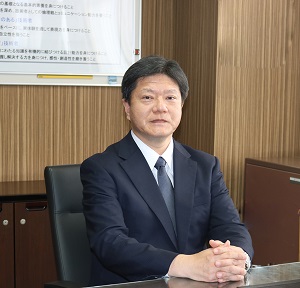 | President NOGUCHI Ken
|
National Institute of Technology, Tokuyama College was established in 1974 to meet society’s increasing demands for engineers. The educational purpose of this college is to foster individuals who will be able not only to pursue technology but also to gain the trust of others, and to contribute to the sustainable development of society and universal happiness. Since its founding, this institution has offered professional qualifications in the field of science and technology for a variety of occupations and industries.
There are two courses available: Regular Course which is a five-year Associate Degree of Engineering program after finishing junior high school and Advanced Course which is a two-year Bachelor Engineering Degree program after completing the Regular Course. Each course has its own vision. It is essential that both courses meet society’s high expectations. For this reason, we educate prospective engineers with the skills for solving technological problems in the Regular Course, and produce engineers capable of conducting research and development in the Advanced Course. We offer professional qualifications based on information technology in both courses.
Now, we are going to introduce the Model Core Curriculum (MCC) from 2011. The MCC ensures that students will receive an education of the highest quality through autonomous learning, encouraging them to recognize and assess their own level of understanding and skills.
It is our strong desire that each student learns and masters a wide variety of advanced technologies and acquires knowledge not only in their major field, but also in other fields. We hope they have a fruitful and memorable experience on the NIT, TC campus.
History of our college
National Institute of Technology, Tokuyama College was established in June, 1974 to correspond to the strong demand from the society. It is composed of three departments: Mechanical & Electrical Engineering, Computer Science & Electronic Engineering and Civil Engineering & Architecture. In the each interdisciplinary and specialized fields, students are expected to acquire a basic theory, to have a lot of experimental practices and to become not only an engineer but also a developer with the ability of taking initiatives and considering all the various factors.
| Year | Date | Event |
|---|---|---|
| 1971 | December 20 | An association was organized for establishing Tokuyama College of Technology. |
| 1973 | December 29 | The foundation of Tokuyama College of Technology was decided in the Cabinet meeting. |
| 1974 | June 7 | Tokuyama College of Technology was established. Onzo Jo was appointed as the first president. |
| 1975 | March 28 | The construction of the main school building, dormitory and gymnasium were completed. (The 1st phase main building construction ) |
| June 7 | The ceremony of the first anniversary of the founding of a school was held. | |
| 1976 | March 27 | The constructions of Engineering Department Building, Building for Practice and Experiments, Electronic calculator room, Library were completed. (The 2nd phase construction) |
| 1977 | March 31 | An athletic field, a baseball ground were built. |
| April 1 | The general affairs section, the accounting section, the students affairs section were placed in the administration bureau. | |
| 1979 | March 16 | The 1st graduation ceremony was held. |
| 1982 | March 31 | The facilities of welfare and Judo were built. |
| 1983 | March 30 | The second gymnasium and A facility of training camp were built. |
| 1987 | April 1 | Started to accept foreign students. |
| 1991 | March 12 | Men’s dormitory got repaired and Women’s dormitory was built. |
| October 1 | The development center for cooperation of community began. | |
| 1992 | April 1 | A five-day school week was introduced. |
| 1994 | April 7 | The development center for cooperation of community was replaced by Center for Collaborative Research and Education. |
| June 23 | The construction of environmental maintenance (green the campus, widen the roads and the maintenance of athletic field in the campus) was completed. | |
| November 4 | The building of Center for Collaborative Research and Education was built. | |
| 1995 | April 1 | Advanced courses were set up: Mechanical and Control Engineering Course, Computer Science and Electronic Engineering Course and Environmental and Civil Engineering Course. |
| 1997 | March 17 | The first ceremony of the completion of advanced courses was held. |
| March 28 | The construction of Advanced Course building was completed. | |
| 1999 | July 31 | Media hall was built. |
| August 30 | A facility of solar power generation was placed. | |
| 2004 | April 1 | The school name was changed to National Institute of Technology, Tokuyama College. |
| May 10 | The engineering education program, Communication and IT-based Engineering was accredited as a general engineering program that is on a par with global standard by JABEE. | |
| June 19 | The ceremony of the 30th anniversary of the founding was held. | |
| 2005 | September 20-23 | Third International Structural Engineering and Construction Conference (ISEC-03) was hosted by NIT, Tokuyama College. |
| 2007 | March 28 | Certified evaluation and accreditation was given by National Institute for Academic Degrees and Quality Enhancement of Higher Education. |
| December 1 | The event of the 10th anniversary of foundation of Center for collaborative Research and Education was held. | |
| 2008 | March 31 | Class rooms and Administration Office building, library, Information Processing Center were repaired for earthquake-resistance. The maintenance of the rotary at the entrance was completed. |
| 2009 | April 23 | The accreditation of Communication and IT-based Engineering by JABEE was determined to be continued. |
| 2012 | March 30 | Engineering Department Building was repaired for an earthquake-resistance. |
| April 27 | The accreditation of Communication and IT-based Engineering by JABEE was determined to be continued. | |
| 2013 | March 27 | Certified evaluation and accreditation by National Institute for Academic Degrees and Quality Enhancement of Higher Education has been decided to be continued. |
| 2014 | September 26 | The ceremony of the 40th anniversary of foundation of school was held. |
| 2015 | March 9 | The accreditation of Communication and IT-based Engineering by JABEE has been determined to be continued. |
| April 1 | An application of giving bachelor’s degree to the students in Advanced course was accredited as special case by National Institute for Academic Degrees and Quality Enhancement of Higher Education. |
Educational System
In the late 1950s, it was essential for Japan whose economy was growing remarkably to foster engineers who can deal with the rapid progress of science and technologies to support the country’s economy. In order to meet the needs for the industry and the society, Colleges of Technology was founded in 1962 (hereinafter referred to as KOSEN). The educational system of KOSEN is different from that of university. KOSEN has accepted graduates of junior high school to give them five-year consecutive education (five and half year in the case of maritime college of technology).
The aim of KOSEN is to offer students well-rounded education. Based on this idea, our school provide them with well-balanced curriculum, including both of liberal arts and specialized fields. Student will develop the university level of knowledge and technology. They are also expected to gain the practical ability to be independent as an engineer. Therefore, some of them conduct academic researches so that they can make presentations at academic conferences.
After the five-year course, we can offer two-year advanced course for students who desire to deepen their knowledge and enhance their technical skill. Once they finish the advanced course, they acquire a bachelor’s degree if they reach the criteria which National Institute for Academic Degrees and Quality Enhancement of Higher Education has set. A lot of students go on to a graduate school after completing this course.
As politics, economy, and industries are globalized, engineers are expected to acquire skills that are accepted in the globalized society. According to this notion, JABEE (Japan Accreditation Board for Engineering Education) was established in 1999. JABEE accredits professional education programs in higher education institution fostering professionals with the benchmark required by JABEE Accreditation Criteria which is international equivalent. The program, “Communication and IT-based Engineering” in advanced course is accredited by JABEE. After students complete the course and the program, they will be awarded a certificate by JABEE.
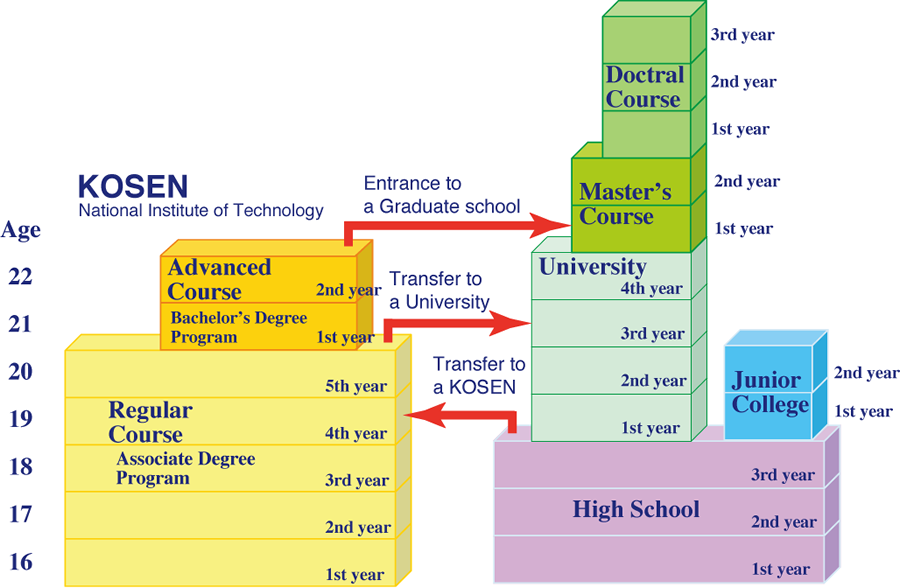
Our Vision of the “Ideal Engineer” at Tokuyama College
We seek to foster engineers upon our founding ideals:
Regular Course
To bring up engineers with technological problems solving skills capable of utilizing interdisciplinary technologies based upon information technology.
Advanced Course
To nurture engineers capable of conducting research and development with interdisciplinary technologies based upon information technology.
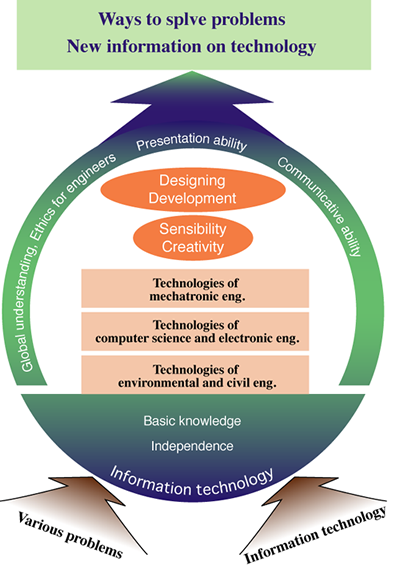
Tokuyama College offers professional qualifications based on information technology for a variety occupations and industries.
Since its founding we have aimed at fostering engineers capable of utilizing interdisciplinary technologies.
There are two courses available – Regular Course and Advanced Course. Each course has its own vision. But essentially both courses
must meet society’s high expectations. For this reason, we nurture engineers with skills for solving technological problems at the
level in the Regular Course, and produce engineers capable of conducting research and development in the Advance Course.
Educational Goal
To educate the students to be future engineers with a world-class competitive edge, practical skills, and competence in research and development.
National Institute of Technology, Tokuyama College has put “to educate the students to be future engineers with a world-class competitive edge, practical skills, and competence in research and development” forward as its educational goal since 1993. Based on the educational goal, our college set the following six concrete goals in 2002. The chart on the left illustrates how these goals are pursued in our college.
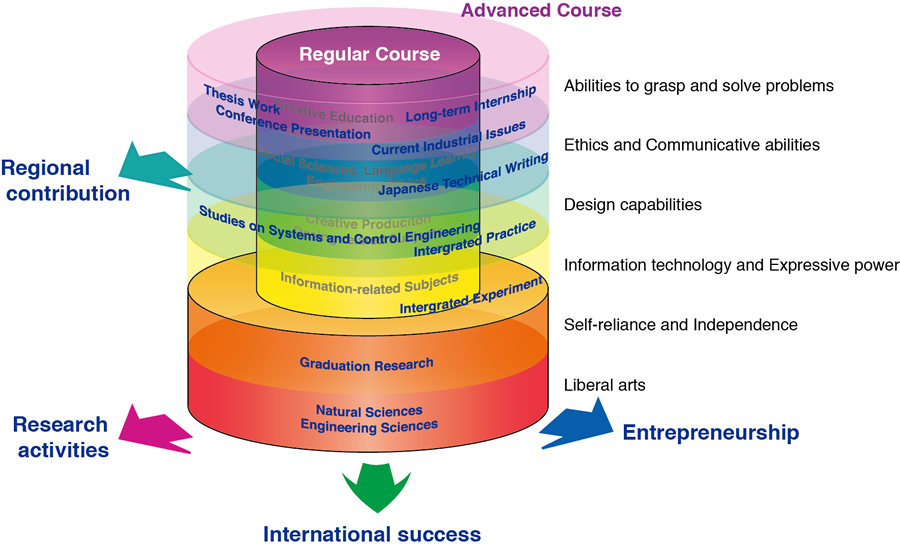
(A) In order to educate our students to be future engineers with a world-class competitive edge, we get them
(A1) to acquire basic knowledge to apply to interdisciplinary fields, and
(A2) to deepen their global understanding, cultivate their ethics for engineers, and improve their communicative ability.
(B) In order to educate our students to be future engineers with practical skills, we get them
(B1) to be able to utilize information technology and improve their presentation ability through practice and internship
programs, and
(B2) to be independent.
(C) In order to educate our students to be future engineers with competence in research and development, we get them
(C1) to improve the ability to combine and organize their knowledge of various fields, and
(C2) to be able to analyze, address and solve problems and polish their sensibility and creativity.
JABEE
WHAT IS JABEE
Japan Accreditation Board for Engineering Education
JABEE stands for Japan Accreditation Board for Engineering Education. By assessing and accrediting the engineering education programs provided by institutions of higher education such as colleges of technology and universities, JABEE ensures the international equivalency of the quality of education the colleges and universities offer. JABEE has been accredited by Washington Accord which is an international agreement among bodies responsible for accrediting engineering degree programs since 2005. JABEE assesses and accredits the whole process of education at Japanese colleges and universities including educational environments. The ultimate goal of JABEE is to raise the level of engineering education programs in Japan to a global standard.
Engineering Education Program
Communication and IT-based Design Engineering
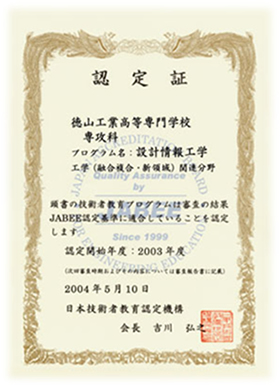 At our college, the engineering education program, “Communication and IT-based Design Engineering” is accredited by the Japan Accreditation Board for Engineering Education. The program is constituted in the curriculum of the fourth and fifth grade in the general course and advanced course.
At our college, the engineering education program, “Communication and IT-based Design Engineering” is accredited by the Japan Accreditation Board for Engineering Education. The program is constituted in the curriculum of the fourth and fifth grade in the general course and advanced course.
Our college has three different undergraduate courses followed by three corresponding advanced courses, and the JABEE program has been applied to the all courses so that all the students will have an opportunity to learn not only the specialized fields but also other areas which are significant to be a professional engineer.
Any student who completes the Communication and IT-based Design Engineering program is guaranteed to get a university-level education. On top of that, those students are expected to play an active part as a competent engineer in various areas of research and development in a highly-developed information-oriented society.
College Organization
Regular Course and Quota
| Department | Quota | Total |
|---|---|---|
| Department of Mechanical and Electrical Engineering | 40 | 200 |
| Department of Computer Science and Electronic Engineering | 40 | 200 |
| Department of Civil Engineering and Architecture | 40 | 200 |
| Total | 120 | 600 |
Advanced Course and Quota
| Course | Quota | Total |
|---|---|---|
| Mechanical and Control Engineering Course | 4 | 8 |
| Computer Science and Electronic Engineering Course | 4 | 8 |
| Environmental and Civil Engineering Course | 4 | 8 |
| Total | 12 | 24 |
Present Number of Staff
As of Apr. 1. 2024
| Classification | Academic Staff | Technical Staff | Administrative Staff | Total | |||||||
|---|---|---|---|---|---|---|---|---|---|---|---|
| President | Professor | Professor on a short-term contact | A Specially Appointed Professor | Associate Professor | A Specially Appointed Associate Professor | Lecturer | Assistant Professor | ||||
| Present Number | 1 | 17 | 2 | 2 | 25 | 1 | 0 | 10 | 10 | 51 | 119 |
Administrative Staff
As of Apr. 1. 2024
| President NOGUCHI, Ken | Chief of Student Counseling Office NITTA,Takayuki |
| Vice President (Dean of Academic Affairs) HARIMA,Takashi | Chief of Career and Learning Support Office YAMAMOTO,Takuo |
| Vice President (Dean of General Administration) NISHIMURA, Futoshi | Chief of International Exchange Office EMOTO,Akemi |
| Assistant President (Dean of Student Affairs) KURAMASHI,Yasuhiro | Chief of Institutional Research for Educational Improvement Office KIKUCHI,Yuma |
| Assistant President (Dean of Dormitory Affairs) MUROTANI,Hideaki | Chief of Mechanical and Electric Eng. IKEDA, Mitsumasa |
| Assistant President (Chief of Advanced Courses) URAKAMI,Misako | Chief of Computer Science and Electronic Eng. SHIGEMURA, Tetsuji |
| Assistant President (Chief of Planning and Coordination Officer) KATAYAMA,Kosuke | Chief of Civil Eng. and Architecture SHIMABUKURO, Atsushi |
| Assistant President (Director of Research Promotion Division) KAITA,Tatsumasa | Chief of Liberal Arts Division TAKAHASHI,Shogo |
| Director of Center for Collaborative Research and Education MEYAMA,Naoki | Director of the Administration MURASHIGE,Kiyoshi |
| Director of Support Center for Education and Research NISHIMURA, Futoshi | Chief of General Administration Division MORIMOTO,Kazuhiro |
| Director of the Library NISHIMURA, Futoshi | Chief of Student Affairs Division MIURA,Satoshi |
| Director of Information Processing Center KUWAJIMA,KEiji |
Organization Chart

Committees
| Steering Committee | Bullying Measures Committee |
| Personnel Committee | Moral Committee of Human Medical Research |
| Budget Committee | Facilities Management Committee |
| Risk Management Committee | Intellectual Property Committee |
| Academic Affairs Committee | Information Security Management Committee |
| Advanced Course Committee | Information Security Promotion Committee |
| Admissions Committee | School Safety and Hygiene Committee |
| Student Affairs Committee | Harassment Prevention Committee |
| Student Services Committee | Committee for Promotion of Gender Equality |
| Dormitory Affairs Committee | Export Management Committee |
Campus Information
Access to Shunan

From Fukuoka to Syunan
1.Fukuoka Airport (International Terminal)
Free Shuttle Bus (10min)
2.Domestic Terminal
Walk (5min)
3.Fukuoka Airport St.
Subway (6 min)
4.Hakata St.
JR Bullet Train (1h20min)
5.Tokuyama St.
From Tokyo to Syunan
1.Tokyo St.
JR Bullet Train(4h15min)
2.Tokuyama St.
Access to NIT, Tokuyama College
When you arrive at Tokuyama Station, take a Bocho Bus at the bus stop NO.6 for NIT, Tokuyama College.
Bocho Bus Time table < From Tokuyama St. to NIT, Tokuyama College >
| Depart | 7:50 | 8:00 | 8:12 | 8:15 | 8:25 | 8:30 | 8:35 | 12:15 |
|---|---|---|---|---|---|---|---|---|
| Arrive | 8:12 | 8:17 | 8:29 | 8:32 | 8:42 | 8:47 | 8:52 | 12:39 |
Fare:¥260 (One-way)
You can also take a taxi. There is a taxi station by the bus terminal.
To get more information, contact us at:
・E-mail: [email protected]
・TEL:+81-834-29-6200
・Address: NIT, Tokuyama College
Gakuendai, Shunan City, Yamaguchi Pref., Japan
745-8585
